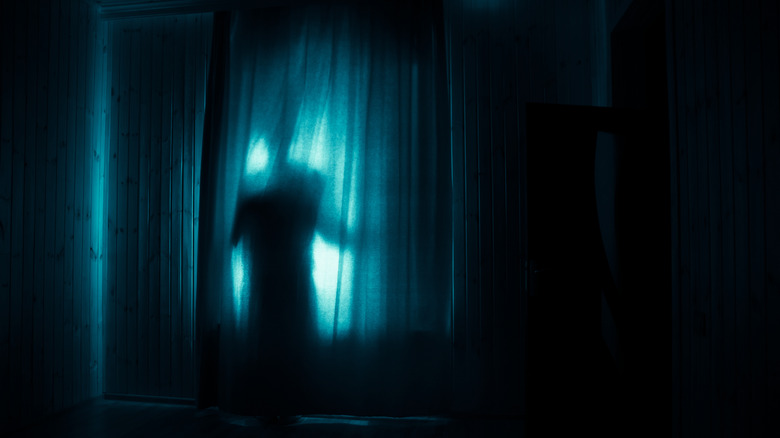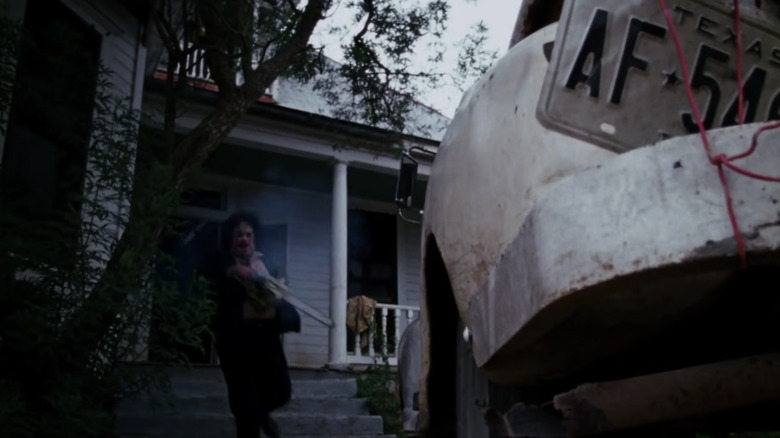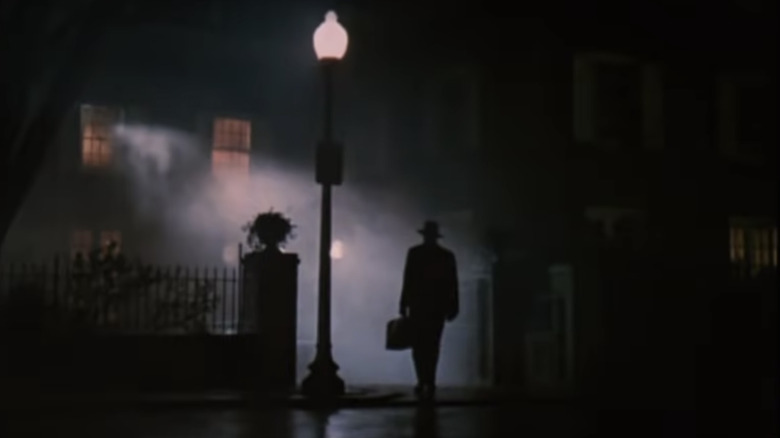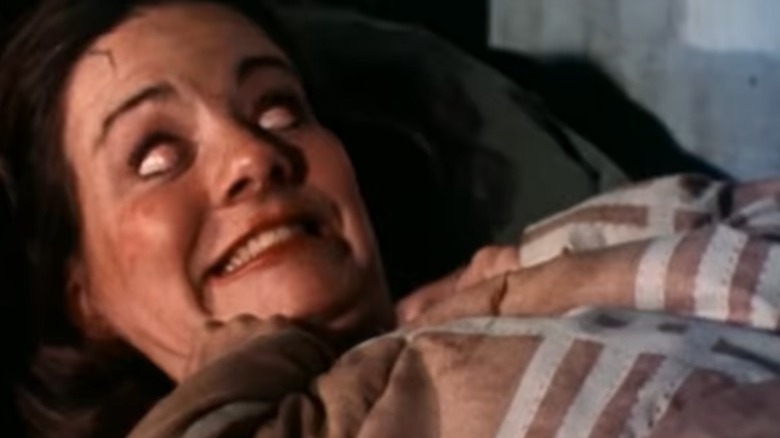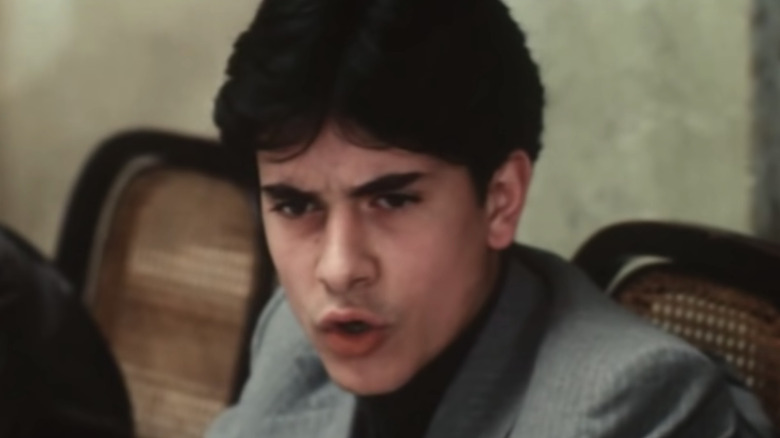Disturbing Horror Movies That Wound Up Getting Banned
Horror movies can be a real slippery slope when it comes to artistic expression and freedom of speech. On one hand, artists can create films that make our skin crawl for entertainment, or make us critically look at our surroundings — even if the end result disturbs us. On the other hand, there's a very fine line between pushing boundaries and subjecting viewers to seemingly senseless obscenity. Alas, that's where a critical question arises: Who's responsible for enforcing that line — public entities or viewers themselves? It's a question that has (and likely will continue to) spark some serious debate.
That being said, there are those scary movies that some felt were too disturbing, gory, grotesque, or downright terrifying to screen. The kicker? Some of them are now considered cult-classics or horror film staples. The following horror movies were banned at one point due to their disturbing nature ... how many have you seen?
The Texas Chain Saw Massacre (1974) and the Texas Chain Saw Massacre Part 2 (1986)
Many horror enthusiasts consider "The Texas Chain Saw Massacre" to be a must-watch classic, but there was a time where the brutality and menace of Tobe Hooper's Leatherface was simply too much for viewers to handle. The influential 1974 flick tells the story of a group of friends falling victim to a twisted family of social pariahs, with the chainsaw-wielding Leatherface inflicting some seriously gruesome pain on the pals (via Rotten Tomatoes).
Turns out, not everyone appreciated the stomach-churning gore and terror. The film has been banned in several countries over time, including Ireland, Chile, Norway, and Sweden (via The Independent.) According to the British Board of Film Classification (BBFC), the film was banned in Britain in 1975 for not just its violence but the psychological terror inflicted upon its characters. It remained banned in Britain until the late '90s.
The original "Texas Chain Saw Massacre" wasn't the only film in the horror franchise to be banned. Its sequel, 1986's "The Texas Chain Saw Massacre Part 2," was also banned in several countries, including Australia (which banned it for two decades) and Britain. The film finally got a United Kingdom release in 2001, 15 years after its initial ban (via The Guardian).
I Spit On Your Grave (1978)
This controversial 1978 horror film showed us that revenge isn't always best served cold; sometimes, it's best served disturbingly brutal and without mercy. "I Spit On Your Grave" tells the story of a writer getting revenge on the men who leave her to die after assaulting her (via IMDb). The film's graphic nature clearly rubbed people the wrong way, including film critic Roger Ebert, who called it "a vile bag of garbage" (via The London Economic).
As you can probably tell from the synopsis, the film is chock-full of graphic violence — so much so that it was banned in several countries, including Ireland and Australia, where, according to Refused Classification, it received a 1998 ban that was lifted in 2004. In fact, the Irish Film Classification Office wound up banning the infamous horror flick's DVD re-release decades after the movie was originally released — a move that wasn't normal for the time (via The Irish Times). The call was reportedly made due to the movie's "acts of gross violence and cruelty towards humans."
The Human Centipede II (Full Sequence) (2011)
Anyone who saw 2009's "The Human Centipede" can vouch for its disturbing and seriously gross concept — a mad German scientist kidnapping people and turning them into a human centipede, attaching them mouth to (brace yourself) rectum (via IMDb.) Yes, it's vile and inhumane — but it's tolerable compared to its grisly sequel.
2011's "The Human Centipede II (Full Sequence)" takes the grotesque nature of the original up a horrific notch. It follows a depraved man trying to create his own human centipede after seeing the original film (via Rotten Tomatoes.) The film features some truly horrid scenes, and its unsettling nature made it a film non grata in the U.K.
According to NME, the BBFC said it was "unacceptable material" and refused to classify it in June 2011, noting its sexual violence and obscenity. The Guardian also reports that the BBFC originally said nothing could be done to get it a certification; however, it was eventually granted an 18 classification in October 2011 after more than 30 cuts were made (via the BBC). The film was also banned in Australia, according to SBS.
Believe it or not, the criticism of the shocking and vile nature of "The Human Centipede II" didn't kill the franchise. "The Human Centipede III (Final Sequence)" was released in 2015. The film stars Eric Roberts and takes place in a prison (via the BBC.) You can guess what happens behind those walls.
A Serbian Film (2010)
It's a film that's been called atrocious (via The Independent) and is notorious for its extremely violent and straight-up wicked scenes. 2010's "A Serbian Film" is not for the faint of heart — and even the most seasoned horror fans may be left scarred after watching. The movie is about an aging porn star who, desperate to make some cash, agrees to do a film ... but he later finds out it's a snuff film with truly disgusting and devastating themes (via IMDb).
The film was considered so shocking and dreadful that it was banned in several countries, including Malaysia, Australia, and Spain (via The Independent). Variety reports that a Spanish court actually temporarily banned the movie from being shown at a festival due to its disturbing nature. An edited version of the film was released in the U.K., with a total of four minutes of the movie being cut, according to The Independent.
The film's director, Srđan Spasojević, has defended the film amid the public outcry over it. In an interview with Indie Wire, Spasojević says the movie was inspired by the desire he and his co-writer had to express their feelings towards political correctness and Serbian politics. Whether those themes clearly come through in the movie is up for debate.
The Exorcist (1973)
The spinning head, the shaking bed, the creepy stairs scene ... you know which movie we're talking about here. Considered by many to be a highly influential horror movie and one of the scariest movies ever made, 1973's "The Exorcist" scared the daylights out of viewers as they watched two priests try to save a young girl possessed by a demon (via IMDb.) The terrifying supernatural themes and the special effects made it a horror classic, but not everyone saw its deliciously scary appeal. It was considered so frightening at the time that, according to the BBFC, some moviegoers in the United States fainted and vomited while watching. Yikes.
While the BBFC didn't outright ban the movie in Britain upon its release, the organization reports that some areas in the country decided to ban it on their own accord. Years later, in 1988, the BBFC pulled video copies of "The Exorcist" from shelves so it wouldn't fall into children's hands. It wouldn't be cleared for video release until the late 1990s, after it was relaunched in U.K. theaters for its 25th anniversary in 1998. According to The Guardian, BBFC leadership felt that enough time had passed since the film's release, and people had a more sensible reaction to its viewing — meaning they didn't have to worry about audiences fainting at the sight of Linda Blair's spinning head.
Cannibal Holocaust (1980)
Nearly two decades before "The Blair Witch Project" brought the found-footage horror movie to the mainstream, a different horror flick pioneered the style in an unsettling fashion. 1980's "Cannibal Holocaust" is an Italian horror movie about a film crew going missing in the Amazon, and the brutal footage showing what happened (via Rotten Tomatoes). Its grotesque and cruel scenes led to it being banned in countries like Italy, Australia, and the U.K., according to CBS. It got approval for release in the U.K. in 2001 after numerous cuts were made (via the BBFC).
Why was the film so controversial? According to Screen Rant, the film's graphic showing of animal death caused a stir, as well as scenes depicting sexual violence and tons of gore. Screen Rant also reports that at one point, the movie's director, Ruggero Deodato, faced murder charges because of circulating rumors that actors were actually killed for the movie. Alas, the rumors were false, and he was cleared of the charges after the actors were proven to be alive.
The Last House on the Left (1972)
Legendary horror director Wes Craven gave us some of the best horror films ever created, including "A Nightmare on Elm Street" and "Scream." What many people may not realize is that Craven's debut film, "The Last House on the Left," also made a big impression ... but not for the best reasons.
"The Last House on the Left," based on 1960's "The Virgin Spring," is a brutal story of revenge centered around a group of criminals who commit unspeakable acts against two girls. They eventually wind up in the house of one of the girls' parents — and you bet the parents want them to pay the price.
The horrific concept and gritty violence in the film led to it getting an R rating in the United States (via Rotten Tomatoes). The BBFC wound up rejecting the film for classification across the pond. It was banned in Britain until 2002, when it received an 18 classification for DVD release after several cuts were made. According to Screen Rant, the BBFC didn't allow the uncut version to be released on video until 2008. The film also encountered hurdles in Australia, where it wasn't even released amid censorship issues (via CBR).
The Evil Dead (1981)
It's the movie that made horror fans everywhere second guess taking a trip to the woods. 1981's "The Evil Dead" tells the grisly tale of five college students going through hell after accidentally releasing demons during a trip to remote cabin (via Rotten Tomatoes.) While it's considered by many to be a cult-classic scary movie, it didn't get nearly as much admiration when it was released.
Anyone who's seen "The Evil Dead" knows it's a gruesome film, filled with plenty of blood, violence, and gore to go around. The shocking images and frightening themes led to the film being banned in several countries across the globe, including Singapore, Ukraine, and Finland (via the University of Delaware). Surprisingly, it wasn't banned in Britain. According to the BBFC, it was given an "X" certificate after several cuts were made. The video version, however, was added to the infamous "video nasties" list.
Despite "The Evil Dead" being banned in several countries, it grew into a franchise with 1987's "The Evil Dead II" and 1992's "Army of Darkness" (via IMDb). The original flick even got a remake in 2013. Not a bad legacy for a banned low-budget horror flick.
A Clockwork Orange (1971)
Stanley Kubrick gave us cinema classics like "Full Metal Jacket,” "2001: A Space Odyssey," and "The Shining." He's also the director behind 1971's "A Clockwork Orange," a film that depicts a dystopian Britain filled with crime (via IMDb). It doesn't sound all that bad (how many violent dystopian films have been made since?), but the film's graphic violence makes it deeply disturbing. It features ruthlessly violent acts lead by depraved gang leader Alex DeLarge — acts that truly unsettled many moviegoers. Screen Rant reports that the controversial film was banned in countries like Ireland, Spain, South Africa, and Singapore.
According to PBS, it was released in Britain with no cuts in 1971, and Brits debated whether Kubrick's film should be praised for its artistry or condemned for its lack of morality and decency. The debate went on until 1973, when Kubrick himself decided to ban "A Clockwork Orange" in the U.K. As Far Out Magazine reports, stories in the British media attributing alleged copycat violent crimes with the film may have influenced Kubrick's decision.
Despite the controversy surrounding "A Clockwork Orange," it gained a cult following and even got several nominations at the 44th Academy Awards (via American Cinematographer.) Variety reports it was also selected as an addition to the United States National Film Registry in 2020.
Salò, or the 120 Days of Sodom (1975)
There are the horror movies that make you scared of the things that go bump in the night — and then there are horror movies that make you scared of people lurking in society's darkest shadows. 1975's "Salò, or the 120 Days of Sodom," falls into the latter category.
Set during World War II, the movie is about four wealthy libertines who round up adolescents and commit truly heinous acts against them (via IMDb.) While it's meant to explore themes like absolute power and fascism, its brutal depiction of torture, murder, and rape has led it to being dubbed full of depravity and indecent — and those are just a few of the tamer words. Time hasn't made its vileness easier to stomach, either. A 2008 Los Angeles Times piece states, "There is a cruel, chilling timelessness to both its imagery and its logic. The shock hasn't worn off in the slightest." And that was written 33 years after its release.
The film was such a vile shock that it was banned in countries like Australia and Britain. According to the BBFC, it was denied certification in 1976 on the grounds of gross indecency, but an uncut version was given the okay to be distributed in the U.K. in 2000.
Saw VI (2009) and Saw 3D (2010)
Jigsaw first started playing his twisted games with us in 2004, and while they were brutal from the beginning, movies in the gory "Saw" franchise didn't get banned — until "Saw VI" came out in 2009. "Saw VI" finds Jigsaw's gruesome games continuing after his death (via Rotten Tomatoes). As is the case with any film in the "Saw" franchise, the film is filled with some serious violence and gore.
However, there's something about the sixth installment that rubbed certain countries the wrong way. According to The Hollywood Reporter, its extreme violence persuaded the Spanish Culture Ministry's Film Institute to give the film an X rating in Spain, a classification that was typically reserved for pornography. CBS reports the film was also banned in countries like Thailand and Trinidad and Tobego.
The franchise's next film, 2010's "Saw 3D," also got a ban. It was banned in Germany for its violence (via Den of Geek), and its trailer got a ban in the U.K. after a 10-year-old complained that it was distressing (via the BBC).
Possession (1981)
Horror movies filled with blood and guts are no doubt disturbing, but at least you have an idea of what you're getting into. Horror movies filled with tense psychological terror, on the other hand, can be horrifyingly unpredictable — as 1981's "Possession" proves. It tells the story of a woman who seems to go mad after asking her husband for a divorce (via IMDb.) Seems like a tame enough concept, right? Wrong. So, so wrong.
Far Out Magazine reports that the film was so disturbing that it was added to the "video nasties" list and banned in the U.K. and the United States. It did eventually get released in the U.S. but only after significant cuts were made (via Collider.) Despite its ban, it developed a cult following and is often considered a horror classic worth watching. It also got some critical acclaim, and according to Far Out Magazine, lead actress Isabelle Adjani took home the award for Best Actress at the 1981 Cannes Film Festival. Not bad rep for a flick deemed a "video nasty."
Faces of Death (1978)
Fair warning: The mere premise of this movie is enough to send chills down your spine. Often considered one of the most shocking movies ever created, 1978's "Faces of Death" is a mockumentary movie all about death — both reenacted scenes and alleged real instances of people dying (via IMDb.) According to The Guardian, some truly shocking scenes depict dead bodies cut open and a man being electrocuted. Real or not, those are chilling images to see.
After reading its synopsis, you may wonder, "why would someone ever want to produce such a film?" As Deadspin reports, director John Alan Schwartz jumped on the opportunity to "go around the world and tell a story about death." Some countries didn't exactly share his enthusiasm for the macabre, though. "Faces of Death" was banned in the U.K. and in Australia for its violence, and three of its sequels remain banned in the Land Down Under.
